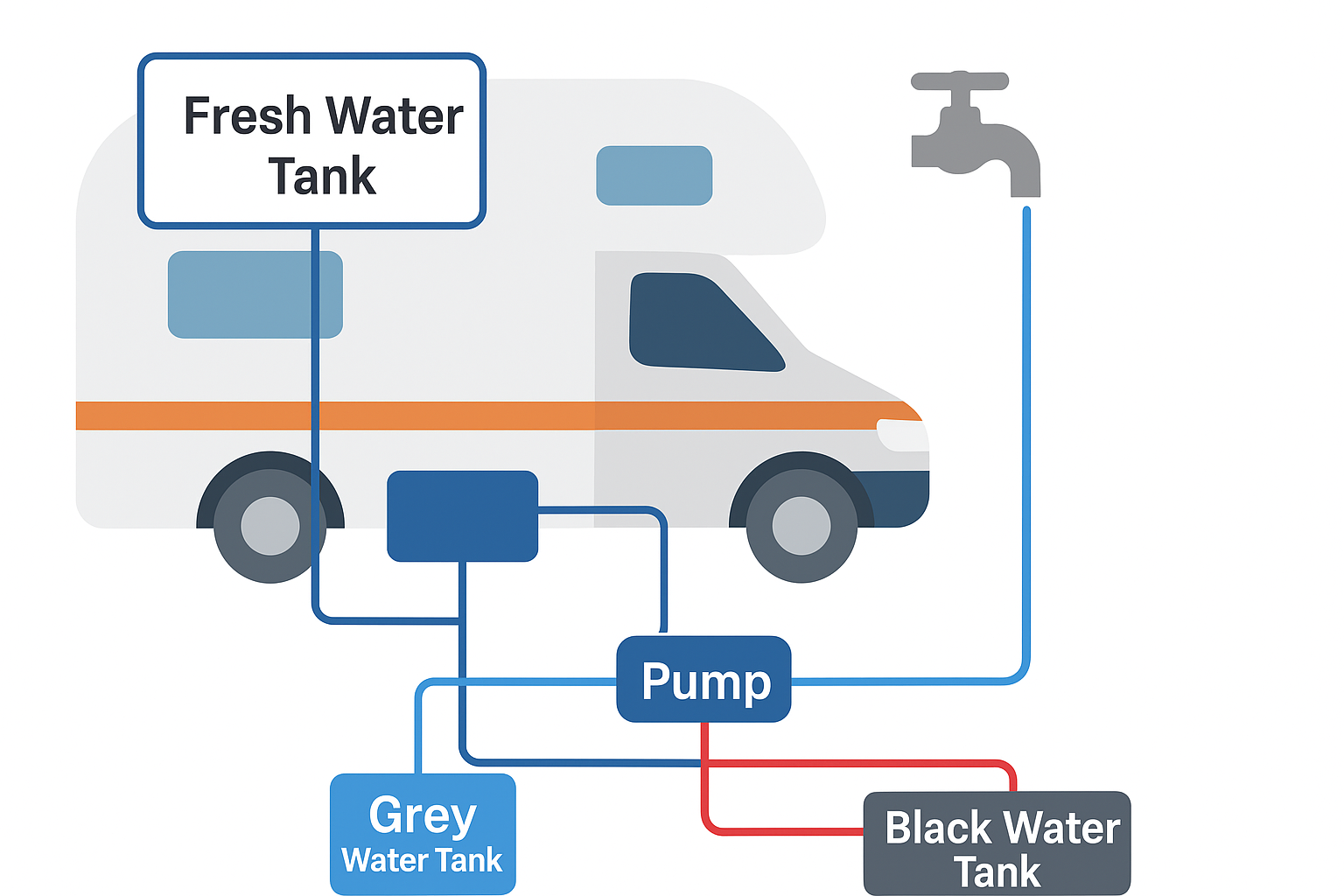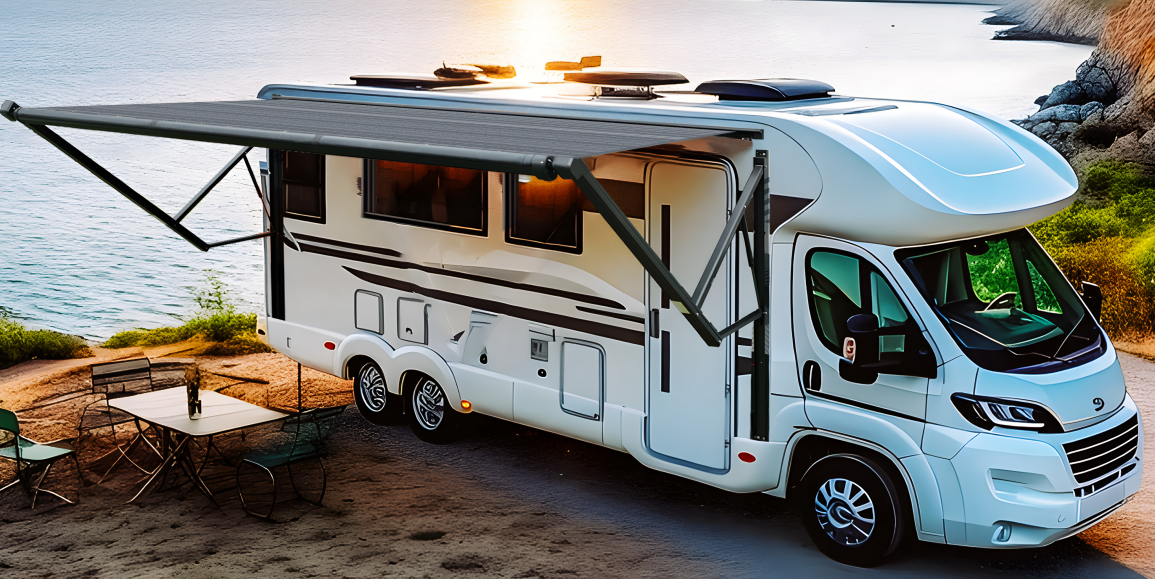Вступ: Чому Життя в каравані нерозривно пов’язана з балансом «вода та електрика»?
Чарівність РВ життя полягає в тому, щоб ви могли вирушити в дорогу зі своєю родиною. Ви можете таборувати на дикій природі або зупинитися в добре обладнаному кемпінгу. Однак кожен досвідчений мандрівник знає, що вода та електрика є двома найціннішими ресурсами. Без води утруднені повсякденна гігієна, приготування їжі та прання; W без електрики припиняють роботу освітлення, холодильники, кондиціонери та водонагрівачі.
Подовження періоду перебування віддалених місцях із обмеженою водою та електрикою є ключовим питанням подорожей на автомобілі-домі, особливо віддалених районах. У цій статті ми розглянемо, як досягти тривалого комфорту під час подорожей на природі концентруючись на Системи водопостачання для автодомів та впровадження інноваційних функцій the Awnlux SA5710 сонячний навіс .
1. Вода для автодомів Наука про систему водопостачання: звідки береться вода і куди вона подівається?
Система водопостачання автодому зазвичай включає такі частини:
РВ Бак з чистою водою
Зберігає чисту воду, місткість зазвичай 80-150 літрів (середнього розміру автодоми), а в деяких великих автодомах може досягати понад 200 літрів .
Основні джерела: станції наливу води на кемпінгах, муніципальні водопровідні труби та переносні відра/тоти.
РВ Сірий Бак для води
Збирає кухонний та ванну стоки (наприклад, воду після миття посуду та прийняття ванни).
Місткість зазвичай наближена до об'єму резервуара для рідини.
РВ Чорний Бак для води
Спеціально розроблено для виведення каналізаційних стоків із туалету.
Поширені об'єми: 40–60 літрів .
РВ Насос та система трубопроводів
Насос перекачує воду з резервуара до кранів, душових голівок та водонагрівачів.
Зазвичай використовується напруга 12 В, споживання енергії низьке.

Висновок : Без дозаправки середньорозмірний автодім може забезпечити чистою водою приблизно на 2–4 дні , залежно від звичок використання води.
2. Денне споживання води для будинків на колесах (на прикладі середнього за розміром будинку на колесах)
|
Сценарії використання |
Споживання води за раз |
Зауваження |
|
миити посуд |
5–10 л |
Рекомендується спочатку протерти посуд, щоб зменшити кількість води, необхідної для смивання |
|
Прийняти душ (швидко) |
20–30 л |
Якщо ви увімкнете водонагрівач, ви витратите додаткову електроенергію. |
|
Кухонна їжа/прибирання |
3–5 л |
Переважно використовується для миття овочів і приготування їжі |
|
Злив унітазу |
1–2 л/раз |
Біорозкладні унітази зменшують об'єм зливу |
|
Питна вода/приготування кави |
2–3 л |
на людину на день |
відповідно до добових потреб сім'ї з трьох осіб:
Щоденне споживання води ≈ 30 –100 л
РВ Бак з чистою водою 100 л :
|
Звички використання води |
Вода для життя у будинку на колесах споживання (л) |
Тривалість підтримки (100-літровий бак для чистої води) |
Характеристики |
Поради щодо економії води |
|
Режим економії |
30–40 л |
2,5–3 дні |
Підходить для коротких поїздок або економних користувачів |
- Використовуйте душовий розпилювач - Використовуйте таз для збирання води для чищення зубів/мииття овочів - Використовуйте мінімальний об'єм зливу унітазу |
|
Стандартний режим |
50–70 л |
Приблизно 2 дні |
Поширений у звичайних сім'ях |
- Прийміть 1–2 швидких душа на людину - Мийте посуд з невеликою кількістю гарячої води, а потім висушіть - Уникайте тривалого відкривання крана |
|
Режим високого витрати води |
90–100 л |
Приблизно 1 день |
Кілька людей або високі вимоги до комфорту |
- Повний душ для кожної людини щодня - Часте готування та прибирання - Майже відсутні заходи економії води |
3. Виклик економії води: Чому "електрика" також тісно пов’язана з "використанням води"?
У фургоні ощадження води полягає не тільки у зменшенні відходів; воно також тісно пов’язане з електроенергією .
РВ Постачання гарячої води : Більшість водонагрівачів потребують електричного або газового опалення. Електричне опалення споживає приблизно 1–1,5 кВт·год електроенергії на душ.
Кемпер Робота водяного насоса : Працює за рахунок 12-вольтової електроенергії для безперервної подачі води. Хоча споживання енергії за один раз є незначним, воно накопичується протягом тривалого періоду часу.
Фургон Миття посуду/полоскання : Якщо використовувати разом з електричним водонагрівачем, це призведе до подвійного споживання (вода + електроенергія).
Тому, коли електроенергії недостатньо , користувачі намагаються зменшити використання гарячої води, що впливає на їхній побутовий комфорт.
4. Awnlux SA5710: Подвійний захист РВ тент від сонця та економія води

Awnlux SA5710 інтегрує гнучкі фотоелектричні модулі CIGS в РВ навіси, досягаючи одночасно затінення та виробництва електроенергії. Він забезпечує 2–5 кВт·год електроенергії на добу , що відповідає потребам різноманітних Обладнання для будинків на колесах , включаючи освітлення, водяні насоси, холодильники та водонагрівачі. Стабільна подача електроенергії забезпечує постійний тиск води в насосі, безперервну подачу води до водонагрівача та ефективну роботу кухонних приладів, зменшуючи витрати води, пов’язані з коливанням рівня води, багаторазовим скиданням та очікуванням. Вона також може живити невеликі очисники води та міні-пральні машини, допомагаючи користувачам досягти більш безпечної та ефективної системи водокористування навіть за обмежених водних ресурсів.
кожен додатковий 1 кВт·год електроенергії економить 8–10 л РВ свіжої води (менше холодної води у водонагрівачі + постійний тиск у водяному насосі) "
|
Денна вироблення електроенергії (кВт·год) |
Підтримувані пристрої |
Ефект економії води |
|
1–2 кВт·год |
Водяні насоси, освітлення, побутові прилади |
Насос для води підтримує сталу тиск і потік, щоб уникнути втрат, викликаних коливаннями |
|
2–3 кВт·год |
Холодильник, ноутбук, Wi-Fi |
Кухонні прилади працюють ефективно, зменшуючи зайві витрати води під час миття/готування |
|
4–5 кВт·год |
Водонагрівачі, деякі кондиціонери |
Водонагрівач безперервно подає воду, усуваючи необхідність повторного зливу води і перевірки температури; тривання на вулиці тривалий час зменшує частоту відбору води. |
5. Дослідження випадку: Як Awnlux допомагає подовжити час перебування
Випадок 1: C інг в пустелі Каліфорнія
Проблемні моменти : Спекотне сонце + нестача місць для кемпінгу → Закінчується вода і електрика
Рішення : Навіс Awnlux генерує 4 кВт·год електрики на день, цього достатньо для роботи холодильника, очисника води і водонагрівача, що дозволяє подовжити подорож з 2 до 4 днів.
Випадок 2: Гори Колорадо Трекинг
Проблема : Велика різниця температур вночі, необхідність гарячої води та освітлення
Рішення : SA5710 Сонячний навіс для автодому забезпечує гарячу воду та електрику для освітлення, економить газ і дизельне паливо, зменшуючи зайву вагу.
6. Майбутнє: Розумне управління гідроенергією + Інтеграція сонячної енергії
Власники автодомів у США все частіше прагнуть с розумних і стійких автодомів :
Інтелектуальний контроль рівня води → нагадує користувачам про економію води
Аксесуари з сонячними батареями → тенти, дахові панелі, переносні електростанції
Поєднання економії води та електроенергії → максимізувати автономність на відкритому повітрі
Стратегія Awnlux : Шляхом сонячні маркизи + локальна сервісна мережа компанія допомагає користувачам досягти більш вільного способу життя на природі, збалансовано використовуючи воду та електроенергію.
Висновок
Вода і електрика є основою життя в автодомі. Науково розуміючи систему водопостачання автодому, разом із тим 2–5 кВт·год електроенергії, що надаються щодня компанією Awnlux SA5710 сонячний навіс користувачі можуть значно подовжити час перебування на природі, зберігаючи комфорт. У майбутньому, із розвитком технологій та концепцій ощадження води й електроенергії стане новим стандартом для Туризму на автодомах .
Щоб дізнатися більше про продукцію, відвідайте офіційний веб-сайт Awnlux.
Зміст
- Вступ: Чому Життя в каравані нерозривно пов’язана з балансом «вода та електрика»?
- 1. Вода для автодомів Наука про систему водопостачання: звідки береться вода і куди вона подівається?
- 2. Денне споживання води для будинків на колесах (на прикладі середнього за розміром будинку на колесах)
- 3. Виклик економії води: Чому "електрика" також тісно пов’язана з "використанням води"?
- 4. Awnlux SA5710: Подвійний захист РВ тент від сонця та економія води
- 5. Дослідження випадку: Як Awnlux допомагає подовжити час перебування
- 6. Майбутнє: Розумне управління гідроенергією + Інтеграція сонячної енергії
- Висновок

 EN
EN
 AR
AR HR
HR CS
CS NL
NL FI
FI FR
FR DE
DE EL
EL HI
HI IT
IT JA
JA KO
KO NO
NO PL
PL PT
PT RO
RO RU
RU ES
ES SV
SV TL
TL ID
ID SR
SR SL
SL UK
UK VI
VI SQ
SQ HU
HU MT
MT TH
TH TR
TR MS
MS AZ
AZ KA
KA LO
LO MN
MN MY
MY KK
KK KY
KY
